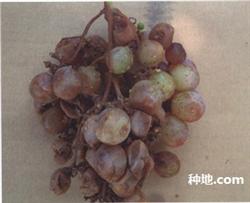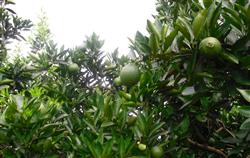How to prevent and cure grape anthracnose?

What harm does anthracnose do to grapes? How to prevent and cure grape anthracnose? Also ask netizens to help introduce the harm of grape anthracnose, causes and prevention methods of grape anthracnose, listed below for your reference. The harm of anthracnose to grape: anthracnose mainly harms fruit, and leaves, new shoots, rachis and tendrils rarely occur. In the early stage of the disease on the fruit, black, round, fly-like spots appeared on the young fruit surface, but the acidity of the young fruit and hard pulp limited the growth of the pathogen, the disease spot did not expand, did not form conidia, and the disease part was limited to the epidermis. Anthracnose begins to color the fruit, the fruit becomes soft, the sugar content increases, the acidity decreases, and enters the peak stage of the disease. Grape anthracnose initially appears round, slightly sunken, light brown spots on the diseased fruit surface, and the spot surface is densely covered with small black particles (conidium disk). When the weather is wet, scarlet sticky matter (spore blocks) can be excluded from the conidium disk, and then the diseased fruit gradually dries up and finally becomes a stiff fruit. Most of the diseased fruits do not fall off, and the whole ear stiff grapes are still hanging on the vines. Anthracnose is rare in leaves and newly diseased spots, mainly oblong and dark brown spots appear on leaf veins and petioles. Scarlet conidia can be seen faintly on the surface of diseased spots in wet weather, but not as obvious as on fruit grains. Incidence time and cause of grape anthracnose: generally, after May or June, when the temperature rises to more than 20 ℃, a large number of spores are formed when the branches with bacteria are drenched by Rain Water. The optimum temperature for the formation of grape anthracnose was 25 ℃-28 ℃, below 12 ℃, and no spores were formed above 36 ℃. The spores of anthracnose spread by wind and rain, germinated and infected, and the pathogen invaded the epidermis of young fruit through the pores in the pericarp. After an incubation period of 10 mi for 20 days, the disease spot appeared, which was the first infection. Some varieties of pathogens invaded the young fruit and did not show symptoms until the fruit began to mature. Anthracnose pathogen can also invade leaves, new shoots, tendrils and other tissues, but does not show disease spots, does not show abnormal appearance, this is a latent infection, this new shoot with bacteria will become the source of infection in the next year. When the grape is nearly ripe, it enters the peak period of disease in rainy weather. Diseased fruits can constantly release conidia and re-infect them repeatedly, causing the epidemic of the disease. The prevalence of anthracnose is closely related to environmental conditions. Rainy, high humidity and suitable temperature are the main reasons for the prevalence of anthracnose. The orchards with low-lying terrain, poor drainage, shallow groundwater and heavy soil viscosity are more serious. The disease is also related to cultivation techniques, extensive management, incomplete cleaning of orchards, serious disease in orchards with many diseased bodies on the shelf, too close row spacing, too large amount of branches, poor ventilation and light transmission, and severe disease in orchards with high microclimate and humidity in the field. The disease is also related to varieties, generally Eurasian species are more susceptible to disease, while European and American hybrids are more resistant. The prevention and control methods of grape anthracnose are as follows: 1. to eradicate the source of overwintering disease: carefully pruning, pruning diseased branches, diseased ears and tendrils; deeply burying leaves, removing diseased remains in time, burying or burning; carefully spraying 50Be stone sulfur mixture + 100fold pentachlorophenol sodium to eradicate overwintering pathogen when budding. 2. Select the non-drop anti-fog film to cover the facility, cover the whole area of the ground in the facility, and pay attention to ventilation and dehumidification, reduce the air humidity in the facility, control the air relative humidity below 80%, restrain spore germination and reduce infection. 3. Turn the soil deeply, deepen the living soil layer, promote the development of root system, increase the application of organic fertilizer, phosphorus fertilizer, potassium fertilizer and trace element fertilizer, and appropriately reduce the amount of available nitrogen fertilizer to improve the disease resistance of the plant itself. 4. Reasonable density, scientific pruning, proper amount of branch retention, reasonable load, maintain strong growth, improve field light conditions, and reduce the air humidity of microclimate. 5. Pay attention to drainage and waterlogging prevention, and it is strictly forbidden to accumulate water in the fields or wet the roots in the summer season, so as not to induce plant weakness and cause diseases. 6. bagging the ear to eliminate the infection of bacteria on the ear. 7. Spray protection in the growing season. Every 15 murals for 20 days, carefully spray 240ml 200 times of Bordeaux liquid to protect the trees. And spray high-efficiency, low-residue, non-toxic or low-toxic fungicides between Bordeaux liquid. The following pesticides can be used alternately: 80% spray gram wettable powder 800 times liquid, 70% gram wettable powder 700 times liquid, 50% carbendazim wettable powder 600 times liquid, 80% anthrax Fumei wettable powder 600 times liquid, 20% Yingguo wettable powder 600 times liquid and so on. In order to improve the control effect, the non-alkaline solution can be mixed with "Tianda-2116" or 1000 times of drought and waterlogging. Supplement: 10% difenoconazole water dispersible granules, active ingredient dosage: 100 mg / kg; 50% arsine. Zinc. Fumishuang wettable powder, active ingredient dosage: 500-1000 times liquid. Click to get grape planting techniques click to get more fruit planting techniques
- Prev

What if there are a lot of rotten fruits when the grapes are ripe?
What if there are a lot of rotten fruits when the grapes are ripe? Advice on the prevention and control of rotten grape fruit during ripening period can refer to the following methods: 1. Thoroughly remove the disease source: remove the disease residue before the branches and vines are off the shelf in autumn, and burn the disease residue centrally; spray 50 times 100 times Solibar or 3 times Solibar or 3 times Solibal before burying the soil in autumn and unearthed in spring.
- Next

Navel Orange planting Technology: how to manage navel Orange Orchard?
How to manage navel orange orchard? Please give a detailed introduction to the management of navel orange orchard, which can be divided into adult orchard and juvenile orchard. Detailed methods can be listed as follows: 1. Fruit protection methods of navel orange: (1) 0.15% Huangjia natural brassin 500 is sprayed on leaves from Xiehua to the second physiological fruit drop period.
Related
- Moge, come on! The staff of the peasant association in the producing area of cantaloupe were frightened when the crowd gathered.
- Causes and Solutions of low Fruit setting rate of Apple
- Symptoms and control measures of passion fruit virus disease
- Fruit growing lesson: how do apple orchards keep high yields?
- Can you build orchards in the mountains? What are the pros and cons?
- How to manage the coloring period of Crisson grape?
- This paper introduces the processing technology of two kinds of fig products.
- How much is a month for retired teachers in rural areas by 2020?
- How can strawberry planting increase sugar content? We should pay attention to management in many aspects.
- What are the cultivation techniques on how to improve the yield of golden fruit?

